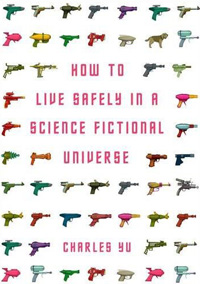 Don’t judge a book by its cover is sound advice. Even wiser words might be a warning that readers shouldn’t judge a book by the blurb a publisher puts on the cover. Even so, Audrey Niffenegger ‘s prominently displayed claim that Charles Yu’s first novel, How to Live Safely in a Science Fictional Universe, was “tremendously clever” made my heart sink.
Don’t judge a book by its cover is sound advice. Even wiser words might be a warning that readers shouldn’t judge a book by the blurb a publisher puts on the cover. Even so, Audrey Niffenegger ‘s prominently displayed claim that Charles Yu’s first novel, How to Live Safely in a Science Fictional Universe, was “tremendously clever” made my heart sink.
Intelligent writing is good but the words “clever” and “intelligent” are not synonymous. A performing monkey is clever. A tap-dancing pony is clever. Clever is showing-off, it is smug and it is complacent. Sadly, clever is also the perfect adjective to describe Yu’s novel.
How to Live Safely in a Science Fictional Universe is a book by Charles Yu in which the narrator, Charles Yu, is given a book (entitled How to Live Safely in a Science Fictional Universe) written by a future Charles Yu which contains the story of Charles Yu. How clever is that?
Charles – the fictional character – is a time machine repair man who has become increasingly dislocated from his own time stream. Things come to a head when he meets a future-self, panics, shoots himself and leaps into his time machine. Charles then spends the rest of the novel worrying about his place in the time loop and his relationship with his father, who invented a time machine when Charles was a boy and then disappeared.
Charles spends a lot of time worrying about being caught in a time loop:
“Wait a minute. Don’t you go through the loop? Should you have some kind of record, some residual memory, some counter for each iteration? How many times have I done this? A hundred? A thousand? Do I ever learn anything from it? Do I ever become a better person?”
It’s a sticky philosophical question. The problem is it’s not one that applies to the situation that the fictional Charles Yu finds himself – despite the novel’s diagram of a time loop on page 91. You see Charles isn’t in a time loop. Present Charles sees his future self, Present Charles shoots his future self, Present Charles sits in his time machine and grumbles for a while, then Present Charles emerges from his time machine, gets shot and dies. There is no loop. There is no reset. Present Charles can only ever go through the process once.
In a novel so keen to display its cleverness this is a serious oversight.
But the novel’s greater problems relate to its emotional core. The relationship between fictional Charles and his distant, long-absent father is supposed to provide the novel’s heart but fictional Charles is such a self-pitying whiner that it is impossible to care about his emotional state. Even in moments when both characters are fully engaged with each other – such when the father presents his invention to the CEO of a major company, a scene obviously intended to be a pivotal moment in their relationship – the fictional Charles is not really concerned with how his father feels but instead engages in a self-pitying whinge about why he isn’t empathic enough to understand his father’s feelings. There could hardly be a better summary of the unpleasantly clammy self-obsession at the heart of this novel.
How to Live Safely… offers no more insight into the disconnection between generations or the essentially isolated nature of the human condition than do the hundreds (possibly thousands) of Hollywood movies made every year where the producers tack on a cliched parent/child conflict as a surrogate for real character development or emotional weight. The novel feels as shallow as the central relationship between father and son. Everything in this novel is surface, every character, every emotional moment, every point of crisis feels designed to show off some terribly clever stylistic tic or writerly flourish. Rather than demonstrating any real interest in the characters on the page or in engaging the readers of his book, authorial Charles Yu seems more interested in parading himself and his command of literary tricks before the audience. The language of the book is tangled and distracting. The metaphors are stretched beyond breaking point and the central science fictional motifs of time travel and alternate universes are not used to move forward the emotional core of the story, instead they obscure it. So we have a novel that replaces emotion with conceptual fireworks and insight with glossy misdirections. Yu’s novel is the bookish equivalent of a Michael Bay film – the pyrotechnics might be literary rather than literal but they serve the same purpose – to distract us from the emotional void at the heart of the story.
Too often reading the How to Live Safely in a Science Fictional Universe felt like being lectured by a smart but slightly autistic teenage boy. They may seem to know a lot about what they are talking about, but you really wouldn’t want to be stuck with them in a lift.